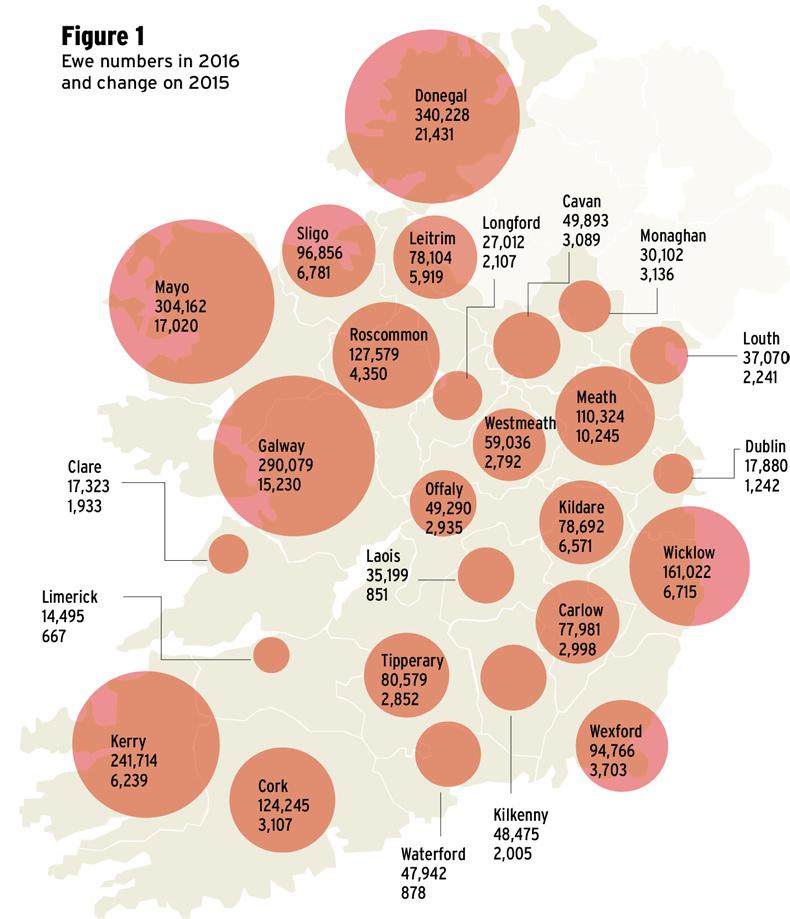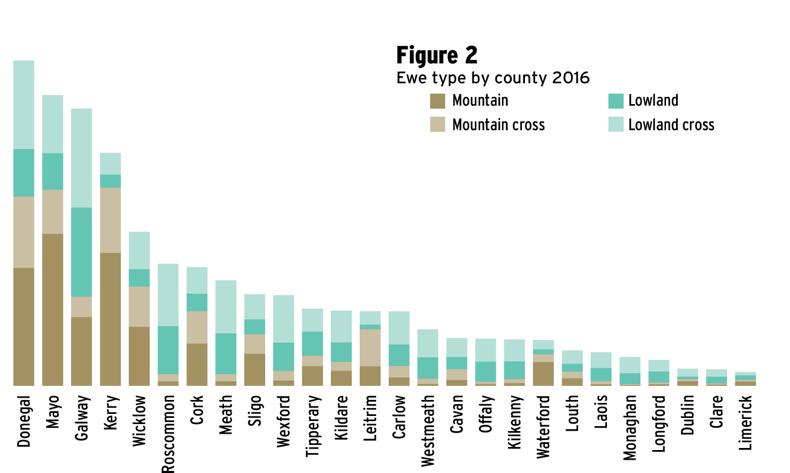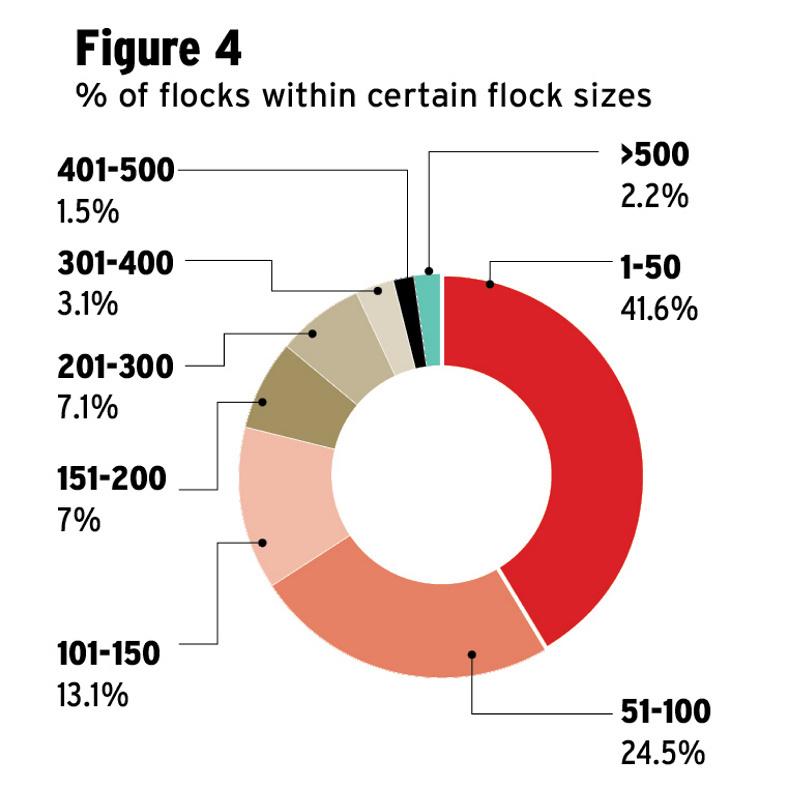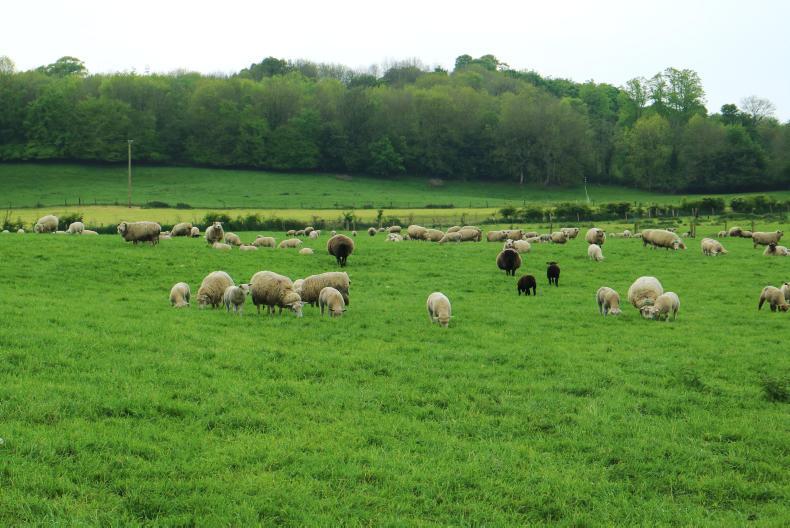The national ewe flock has recorded another year of strong recovery. The 2016 Department of Agriculture National Sheep and Goat Census shows the ewe flock rising 137,037 head to 2.64m ewes.
This follows an increase of 82,637 ewes in 2015 and keeps the flock on an upward trajectory, with total ewe numbers rising 450,000 head since 2009.

The greatest numerical increase occurred in counties Donegal, Mayo and Galway as detailed in Figure 1. Donegal recorded an increase of 21,431 ewes to 340,228, which also follows a rise of 13,146 in 2015, while Mayo retains the position as the second-highest ewe population. With an increase of 17,020 head, it joins Donegal with in excess of 300,000 ewes. Galway, in third position, is keeping pace, with an increase of 15,230 bringing the county’s total flock to 290,079.
These three counties combined account for 35% (934,469) of the national flock. If Kerry (241,714) and Wicklow (161,022) are added into the mix, the top five counties possess 50.6% (1,337,205), or just over half of the national ewe population. There are two major contributing factors, the first of which is the large land area in each county. The second factor is the high percentage of hill and mountain land in these counties and the number of hill ewes this gives rise to.
This is a feature that can be documented, as the 2016 census displays for the first time the number of mountain, mountain cross, lowland and lowland cross ewes in each county. Mountain ewe breeds include Scottish Blackface, Cheviot / North county Cheviot, Kerry Hill, Swaledale, Herdwick, Shetland, Soay and Welsh Mountain. Mountain crosses include crosses of these breeds and also the Easycare, Greyface, Highlander, Hiltex, Mule and Primera breeds. Depending on the system and land type, some of these mountain crosses can also be defined as a lowland cross.
Figure 2 gives a graphical representation of the breakdown of ewe breeds. In total, there are 768,937 ewes, or 29% of the national ewe population, defined as mountain breed. There are 455,994 (17%) in the mountain cross category, 579,359 (22%) in the lowland category, with the largest number of 836,758 (32%) in the lowland cross category.
Delving into the analysis, Kerry has the highest number of mountain ewes at 158,802 head, followed by Mayo with 138,994 and Donegal with 123,232 mountain ewes.

Mountain ewes
The population of ewes in mountain regions has been growing in recent years as changes to commonage management plans are said to be contributing to a number of new flock owners entering the sector and existing flock owners are increasing numbers.
In some marginal areas, there has also been a continued switch in the last two years from reducing cattle enterprises and increasing ewe numbers to deal with inclement weather and related higher production costs.
Reports also point to some farmers retaining higher numbers in anticipation of the Sheep Welfare Scheme. This is reflected right across the country with each of the 26 counties recording an increase in ewe numbers to varying degrees. For example Meath recorded a very significant increase of 10,245 ewes while Sligo, Kildare, Wicklow, Kerry and Leitrim all recorded increases of between 6,000 and 7,000 head.
The number of other sheep on farms increased by 20,563. This follows an increase of 91,471 sheep in this category in 2015. Many had predicted a higher increase given there are over 80,000 extra hoggets slaughtered in the year to date in 2017.
Another feature of the 2016 census is an increase in the number of flock owners as detailed in Table 1. There were an additional 1,059 flocks with sheep in December, bringing the total number of flock owners to 36,313.
It is possible that a number of the extra flocks with sheep last December may have been farms where store lambs were purchased for short-term finishing and remained on farm for longer than normal due to the poor thrive in lambs in 2016, but notwithstanding this it is likely that there are significant numbers of new flock owners with ewes.
As can be expected, Donegal also recorded the greatest increase in flock owners with 196 new flocks, while Mayo and Galway were the only other two counties with over 100 new flocks at 145 and 121 respectively.
Wicklow continues to hold the position of the largest average flock size with an average of 183 sheep last December, a rise of four head on the year previous. Flocks in the east and south east are generally significantly larger with Kilkenny having an average flock size of 164, Waterford 154, Louth 149, Carlow 153, Wexford 146 and Laois 140.
![]()

Read more
Goat numbers fall 1,988 in 2016
The national ewe flock has recorded another year of strong recovery. The 2016 Department of Agriculture National Sheep and Goat Census shows the ewe flock rising 137,037 head to 2.64m ewes.
This follows an increase of 82,637 ewes in 2015 and keeps the flock on an upward trajectory, with total ewe numbers rising 450,000 head since 2009.

The greatest numerical increase occurred in counties Donegal, Mayo and Galway as detailed in Figure 1. Donegal recorded an increase of 21,431 ewes to 340,228, which also follows a rise of 13,146 in 2015, while Mayo retains the position as the second-highest ewe population. With an increase of 17,020 head, it joins Donegal with in excess of 300,000 ewes. Galway, in third position, is keeping pace, with an increase of 15,230 bringing the county’s total flock to 290,079.
These three counties combined account for 35% (934,469) of the national flock. If Kerry (241,714) and Wicklow (161,022) are added into the mix, the top five counties possess 50.6% (1,337,205), or just over half of the national ewe population. There are two major contributing factors, the first of which is the large land area in each county. The second factor is the high percentage of hill and mountain land in these counties and the number of hill ewes this gives rise to.
This is a feature that can be documented, as the 2016 census displays for the first time the number of mountain, mountain cross, lowland and lowland cross ewes in each county. Mountain ewe breeds include Scottish Blackface, Cheviot / North county Cheviot, Kerry Hill, Swaledale, Herdwick, Shetland, Soay and Welsh Mountain. Mountain crosses include crosses of these breeds and also the Easycare, Greyface, Highlander, Hiltex, Mule and Primera breeds. Depending on the system and land type, some of these mountain crosses can also be defined as a lowland cross.
Figure 2 gives a graphical representation of the breakdown of ewe breeds. In total, there are 768,937 ewes, or 29% of the national ewe population, defined as mountain breed. There are 455,994 (17%) in the mountain cross category, 579,359 (22%) in the lowland category, with the largest number of 836,758 (32%) in the lowland cross category.
Delving into the analysis, Kerry has the highest number of mountain ewes at 158,802 head, followed by Mayo with 138,994 and Donegal with 123,232 mountain ewes.

Mountain ewes
The population of ewes in mountain regions has been growing in recent years as changes to commonage management plans are said to be contributing to a number of new flock owners entering the sector and existing flock owners are increasing numbers.
In some marginal areas, there has also been a continued switch in the last two years from reducing cattle enterprises and increasing ewe numbers to deal with inclement weather and related higher production costs.
Reports also point to some farmers retaining higher numbers in anticipation of the Sheep Welfare Scheme. This is reflected right across the country with each of the 26 counties recording an increase in ewe numbers to varying degrees. For example Meath recorded a very significant increase of 10,245 ewes while Sligo, Kildare, Wicklow, Kerry and Leitrim all recorded increases of between 6,000 and 7,000 head.
The number of other sheep on farms increased by 20,563. This follows an increase of 91,471 sheep in this category in 2015. Many had predicted a higher increase given there are over 80,000 extra hoggets slaughtered in the year to date in 2017.
Another feature of the 2016 census is an increase in the number of flock owners as detailed in Table 1. There were an additional 1,059 flocks with sheep in December, bringing the total number of flock owners to 36,313.
It is possible that a number of the extra flocks with sheep last December may have been farms where store lambs were purchased for short-term finishing and remained on farm for longer than normal due to the poor thrive in lambs in 2016, but notwithstanding this it is likely that there are significant numbers of new flock owners with ewes.
As can be expected, Donegal also recorded the greatest increase in flock owners with 196 new flocks, while Mayo and Galway were the only other two counties with over 100 new flocks at 145 and 121 respectively.
Wicklow continues to hold the position of the largest average flock size with an average of 183 sheep last December, a rise of four head on the year previous. Flocks in the east and south east are generally significantly larger with Kilkenny having an average flock size of 164, Waterford 154, Louth 149, Carlow 153, Wexford 146 and Laois 140.
![]()

Read more
Goat numbers fall 1,988 in 2016









 This is a subscriber-only article
This is a subscriber-only article










SHARING OPTIONS: